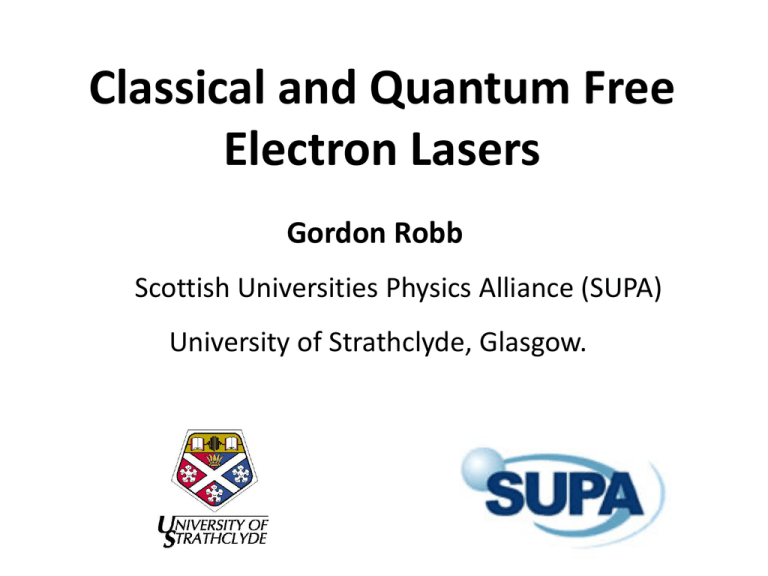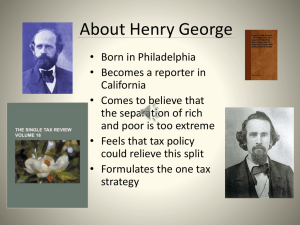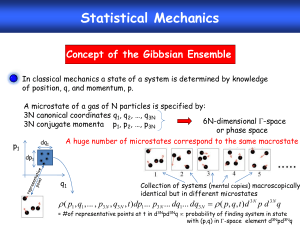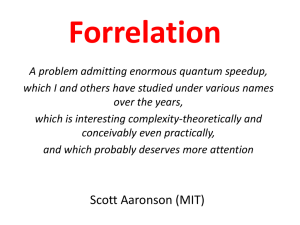2011_Robb
advertisement

Classical and Quantum Free Electron Lasers Gordon Robb Scottish Universities Physics Alliance (SUPA) University of Strathclyde, Glasgow. Content 1. Introduction – Light sources 2. The Classical FEL • Spontaneous emission • Stimulated emission & electron bunching • High-gain regime & collective behaviour • X-ray SASE FELs 3. The Quantum FEL (QFEL) • Model • Results & experimental requirements 4. Conclusions Useful References • J.B. Murphy & C. Pelligrini, “Introduction to the Physics of the Free Electron Laser”, Laser Handbook, vol. 6 p. 9-69 (1990). • R. Bonifacio et al, “Physics of the High-Gain Free Electron Laser & Superradiance”, Rivista del Nuovo Cimento, Vol. 13, no. 9 p. 1-69 (1990). • Saldin E.L., Schneidmiller E.A., Yurkov M.V. The physics of free electron lasers. - Berlin et al.: Springer, 2000. (Advanced texts in physics, ISSN 1439-2674). • Many, many other useful sources on web e.g. www.lightsources.org 1. Introduction – Light Sources Conventional (“Bound” electron) lasers En En-1 hν En En-1 Pros : Capable of producing very bright, highly coherent light Cons : No good laser sources at short wavelengths e.g. X-ray Synchrotrons Pros : Can produce short wavelengths e.g. X- rays Cons : Radiation produced is incoherent Free Electron Lasers offer tunability + coherence 1. Introduction – Light Sources Attractive features of FELs Tunable by varying electron energy or undulator parameters Bu and/or u Spectral reach – THz, VUV to X-ray Cannot damage lasing medium (e--beam) High peak powers (>GW’s) Very bright (>~1030 ph/(s mm2 mrad2 0.1% B.W.)) High average powers – 10kW at Jefferson Short pulses (<100fs 100’s as (10-18s) ) 2. Classical FELs – Spontaneous Emission Radiation from an accelerated charge Stationary electron Relativistic electron v <~ c f Energy emission confined to directions perpendicular to axis of oscillation b q Most energy confined to the relativistic emission cone q = g -1 b 2. Classical FELs – Spontaneous Emission Electrons can be made to oscillate in an undulator or “wiggler” magnet 2. Classical FELs – Spontaneous Emission Undulator radiation simulation in 2-D (T. Shintake) 2. Classical FELs – Spontaneous Emission Consider a helical wiggler field : y Bw z x w The electron trajectory in a helical wiggler can be deduced from the Lorentz force F e v Bw where Bw Bw cosk w z xˆ sink w z yˆ and kw 2 w 2. Classical FELs – Spontaneous Emission Electron trajectory in an undulator is therefore described by x e Bw gmkw 2 sink w z , y y e Bw gmkw 2 cosk w z , z vz t z Electron trajectory in a helical wiggler is therefore also helical x 2. Classical FELs – Resonance Condition Resonant emission due to constructive interference r e- vz u z The time taken for the electron to travel one undulator period: A resonant radiation wavefront will have travelled u r tj vzj u r c r 1 b zj b zj u where: vzj tr Equating: u u b zj vzj c u r c 2. Classical FELs – Resonance Condition Substituting in for the average longitudinal velocity of the electron, bz : 1 bz bz 1 2 1 K2 2γ where e λu BuRMS K 2m c is the “wiggler/undulator parameter” or “deflection parameter” then the resonance condition becomes λu 2 λr 2 1 K 2γ 2. Classical FELs – Resonance Condition The expression for the fundamental resonant wavelength shows us the origin of the FEL tunability: 1 K2 λu λr 2 2γ e λu BuRMS K 2m c As the beam energy is increased, the spontaneous emission moves to shorter wavelengths. For an undulator parameter K≈1 and u=1cm : For mildly relativistic beams (g≈3) : ≈ 1mm (microwaves) more relativistic beams (g≈30) : ≈ 10mm (infra-red) ultra-relativistic beams (g≈30000) : ≈ 0.1nm (X-ray) Further tunability is possible through Bu and u as K∝ Buu 2. Classical FELs – Stimulated Emission Spontaneous emission is incoherent as electrons emit independently at random positions i.e. with random phases. Now we consider stimulated processes i.e. an electron beam moving in both a magnetostatic wiggler field and an electromagnetic wave. EM wave (E,B) electron beam Bw Wiggler/undulator 2. Classical FELs – Stimulated Emission How is the electron affected by resonant radiation ? The Lorentz Force Equation: d γm0 v F -e E v B dt Hendrick Antoon Lorentz The rate of change of electron energy d γm0 c dt 2 e E v 2. Classical FELs – Stimulated Emission Resonant emission – electron energy change v changes E v is +veE v is +ve is +ve Energy of E electron ‘slowly’ when interacting with a resonant radiation field. e- e- u e- 2. Classical FELs – Stimulated Emission Rate ofelectron electronwith energy changephase is ‘slow’ but changes For an a different with periodically with respect respect to radiation field:to the radiation phase E v is +ve - e e- E v is -ve u 2. Classical FELs – Stimulated Emission Gain energy Electrons bunch at resonant radiation d γm0 c 2 e E v wavelength – coherent process* dt E Lose energy vx is +ve Axial electron velocity r Electrons bunch on radiation wavelength scale 2. Classical FELs – Stimulated Emission 2 N N N N i f f if j 2 Radiation power E j e E j E j Ek* e j k j 1 j 1 k 1 j 1 jk Random Perfectly bunched Power N Pi Power N2 Pi For N~109 this is a huge enhancement ! 2. Classical FELs – High Gain Regime In the previous discussion of electron bunching, assumed that the EM field amplitude and phase were assumed to remain constant. This is a good approximation in cases where FEL gain is low e.g. in an FEL oscillator – small gain per pass, small bunching, highly reflective mirrors Usually used at wavelengths where there are good mirrors: IR to UV 2. Classical FELs – High Gain Regime Low gain is no use for short wavelengths e.g. X-rays as there are no good mirrors – need to look at high-gain. Relaxing the constant field restriction allows us to study the fully coupled electron radiation interaction – the high gain FEL equations. The EM field is determined by Maxwell’s wave equation 2 1 Er J 2 Er 2 m0 2 c t t kz t f (z ) Er -Er ( z)sin α xˆ cosα yˆ where The (transverse) current density is due to the electron motion In the wiggler magnet. J e v j r rj (t ) j 2. Classical FELs – High Gain Regime High-gain FEL mechanism Radiation field bunches electrons F -e E v B Bunched electrons drive radiation 1 E J 2 E 2 2 μ0 c t t 2 2. Classical FELs – High Gain Regime dq j The end result is the high gain FEL equations : dz d pj pj iq j c.c.) iq j e iq ( Ae dz 1 dA N dz N e j 1 q j kw k z t j g j g R pj gR 2 E 2 0 A ng R mc 2 z 4z z Lg w Ponderomotive phase Scaled energy change Scaled EM field intensity Scaled position in wiggler Interaction characterised by FEL parameter : ~ 104 103 Newton-Lorentz (Pendulum) Equations + Wave equation 1 K p g 4ckw 2 3 2. Classical FELs – High Gain Regime We will now use these equations to investigate the high-gain regime. We solve the equations with initial conditions q j 0,2 pj 0 (uniform distribution of phases) (cold, resonant beam) (weak initial EM field) A 1 and observe how the EM field and electrons evolve. For linear stability analysis see : J.B. Murphy & C. Pelligrini “Introduction to the Physics of the Free Electron Laser” Laser Handbook, vol. 6 p. 9-69 (1990). R. Bonifacio et al “Physics of the High-Gain Free Electron Laser & Superradiance” Rivista del Nuovo Cimento Vol. 13, no. 9 p. 1-69 (1990). 2. Classical FELs – High Gain Regime High gain regime simulation (1 x ) Momentum spread at saturation : ( P) m cg 2. Classical FELs – High Gain Regime The High Gain FEL Usually used at wavelengths where there are no mirrors: VUV to X-ray No seed radiation field – interactions starts from electron beam shot noise i.e. Self Amplified Spontaneous Emission (SASE) 2. Classical FELs – High Gain Regime Strong amplification of field is closely linked to phase bunching of electrons. Bunched electrons mean that the emitted radiation is coherent. For randomly spaced electrons : intensity N For (perfectly) bunched electrons : intensity ~ N2 It can be shown that at saturation in this model, intensity N4/3 As radiated intensity scales > N, this indicates collective behaviour Exponential amplification in high-gain FEL is an example of a collective instability. High-gain FEL-like models have been used to describe collective synchronisation / ordering behaviours in a wide variety of systems in nature including flashing fireflies and rhythmic applause! 2. Classical FELs – X-ray SASE FELs LCLS (Stanford) – first lasing at ~1Å reported in 2010 X-ray FELs under development at DESY (XFEL), SCSS (Japan) and elsewhere Review : BWJ McNeil & N Thompson, Nature Photonics 4, 814–821 (2010) 2. Classical FELs – X-ray SASE FELs X-ray FELs : science case High brightness = many photons, even for very short (<fs) pulses X-ray FELs will have sufficiently high spatial resolution (<1A) and temporal resolution (<fs) to follow chemical & biological processes in “real time” e.g. stroboscopic “movies” of molecular bond breaking. 2. Classical FELs – X-ray SASE FELs In 1960s, development of the (visible) laser opened up nonlinear optics and photonics Intense coherent X-rays could similarly open up X-ray nonlinear optics (X-ray photonics?) In the optical regime, many phenomena and applications are based on only a few fundamental nonlinear processes e.g. Saturable absorption Q-switching Pulse shortening Mode locking Optical Kerr effect holography Phase conjugation Optical information X-ray analogues of these processes may become possible LCLS Operating Ranges Courtesy of John N. Galayda – see LCLS website for more 2. Classical FELs – High Gain Regime As SASE is essentially amplified shot noise, the temporal coherence of the FEL radiation in SASE-FELs is still poor in laser terms i.e. it is far from transform limited SASE Power output: SASE spectrum: Several schemes are under investigation to improve coherence properties of X-ray FELS e.g. seeding FEL interaction with a coherent, weak X-ray signal produced via HHG. In addition, scale of X-ray FELs is huge (~km) – need different approach for sub-A generation 3. The Quantum High-Gain FEL (QFEL) A useful parameter which can be used to distinguish between the different regimes is the “quantum FEL parameter”, . m cg k ( p) k 1 where 1 2g Induced momentum spread Photon recoil momentum I L aW I 4 A Beam 3 2 3 1 : Classical regime 1 : Quantum effects Note that quantum regime is inevitable for sufficiently large photon momentum 3. The Quantum High-Gain FEL (QFEL) In classical FEL theory, electron-light momentum exchange is continuous and the photon recoil momentum is neglected Classical induced one-photon momentum spread (gmc) >> recoil momentum(ħk) i.e. 1 where mc g k is the “quantum FEL parameter” 3. The Quantum High-Gain FEL (QFEL) We now consider the opposite case where Classical induced one-photon momentum spread (gmc) < recoil momentum(ħk) i.e. 1 where mc g R k Electron-radiation momentum exchange is now discrete i.e. P n k so a quantum model of the electron-radiation interaction is required. 3. The Quantum High-Gain FEL (QFEL) - Model First quantum model of high-gain FEL : G. Preparata, Phys. Rev. A 38, 233(1988) (QFT treatment) Procedure : Describe N particle system as a Quantum Mechanical ensemble Write a Schrödinger-like equation for macroscopic wavefunction: Details in : R.Bonifacio, N.Piovella, G.Robb, A. Schiavi, PRST-AB 9, 090701 (2006) 3. The Quantum High-Gain FEL (QFEL) - Model dq j pj dz Electron dynamical equations dp j dz iq j ( Ae q , p i p2 Single electron Hamiltonian H i Aeiq c.c. 2 Average in wave equation becomes QM average 1 N Maxwell-Schrodinger equations for electron wavefunction and classical field A N e iq j c.c.) p i 2 2 iq q e d j 1 0 1 2 iq i i Ae c.c. 2 z 2 q A z 2 iq e dq iA 2 0 q 3. The Quantum High-Gain FEL (QFEL) - Model Assuming electron wavefunction is periodic in q : (q , z ) inq c ( z , ) e n n |cn|2 = pn = Probability of electron having momentum n(ħk) Only discrete changes of momentum are now possible : pz= n (k) , n=0,±1,.. n=1 pz n=0 n=-1 M-S equations in terms of momentum amplitudes k dcn n2 i cn Acn 1 A*cn 1 dz 2 bunching dA cn c*n 1 iA dz n 3. The Quantum High-Gain FEL (QFEL) =10, no propagation 1 10 (a) -1 10 2 |A| classical limit is recovered for -3 10 1 -5 10 -7 10 -9 10 0 10 20 30 40 50 z many momentum states occupied, both with n>0 and n<0 0.15 (b) pn 0.10 Evolution of field, <p> etc. is identical to that of a classical particle simulation 0.05 0.00 -15 -10 -5 0 n 5 10 3. The Quantum High-Gain FEL (QFEL) _ Dynamical regime is determined by the quantum FEL parameter, _ Quantum regime (<1) Only 2 momentum states occupied p=0 p=-ħk 3. The Quantum High-Gain FEL (QFEL) Until now we have effectively ignored slippage i.e. that v<c When slippage / propagation effects included… CLASSICAL REGIME: 5 Classical regime: both n<0 and n>0 occupied QUANTUM REGIME: 0.1 Quantum regime: only n<0 occupied sequentially 3. The Quantum High-Gain FEL (QFEL) quantum regime L / Lc 30 0.05 classical regime 5 R.Bonifacio, N.Piovella, G.Robb, NIMA 543, 645 (2005) 3. The Quantum High-Gain FEL (QFEL) Behaviour similar to quantum regime of QFEL observed in experiments involving backscattering from cold atomic gases (Collective Rayleigh backscattering or Collective Recoil Lasing (CRL) ) Pump laser L Backscattered Cold field ~ Rb atoms L QFEL and CRL described by similar theoretical models Main difference – negligible Doppler upshift of scattered field for atoms as v <<c. pump light See Fallani et al., PRA 71, 033612 (2005) 3. The Quantum High-Gain FEL (QFEL) Implications for the spectral properties of the radiation : Momentum-energy levels: (pz=nħk, Enpz2 n2) n k k n 1 k 1 1 n En En1 n 2 Transition frequencies equally spaced by 1 with width 4 Increasing the lines overlap for 0.4 CLASSICAL REGIME: 1 → Many transitions → broad spectrum QUANTUM REGIME: 1 → a single transition → narrow line spectrum 0.1 1/ 10 0.3 1/ 3.3 n (2n 1) / 2 [n 0,1,..] 0.2 1/ 5 0.4 1/ 2.5 3. The Quantum High-Gain FEL (QFEL) Conceptual design of a QFEL r L Easier to reach quantum regime if magnetostatic wiggler is replaced by electromagnetic wiggler (>TW laser pulse) mc g k As “wiggler” wavelength is now much smaller, allows much lower energy beam to be used (smaller g) e.g. 10-100 MeV rather than > GeV 3. The Quantum High-Gain FEL (QFEL) Experimental requirements for QFEL : Writing conditions for gain in terms of r , L , : Energy spread < gain bandwidth: (E) E 5 10 4 3/ 2 L r (1 K 2 ) r A , L m m In order to generate Å or sub- Å wavelengths with L 1mm energy spread requirement becomes challenging (~10-4) for quantum regime Bonifacio, Piovella, Cola, Volpe NIMA 577, 745 (2007) May require e.g. ultracold electron sources such as those created by Van der Geer group (Eindhoven) by photoionising ultracold gases. Condition may be also relaxed using harmonics : Bonifacio, Robb, Piovella, Opt. Comm. 284, 1004 (2011) 4. Conclusions FELs offer scientists a new tool that can light up previously dark corners of nature that have hitherto been unobservable. The development of FEL’s has only really begun. We can expect advances in peak powers, average powers, shorter wavelengths and shorter pulses. Currently an exciting time for X-ray FELs with LCLS (SLAC) already online and XFEL (DESY), SCSS (Japan) and others (e.g. MAX4) on the way – a whole new picture of nature awaits… 4. Conclusions Quantum FEL - promising for extending coherent sources to sub-Ǻ wavelengths CLASSICAL SASE-FEL needs: GeV Linac Long undulator (100 m) yields: High Power Broad spectrum QUANTUM SASE-FEL needs: 100 MeV Linac Laser undulator (~1mm) Powerful laser (~10TW) yields: Lower power but better coherence Narrow line spectrum Acknowledgements Collaborators Rodolfo Bonifacio (Milan/Maceio/Strathclyde) Nicola Piovella (Milan) Brian McNeil (Strathclyde) Mary Cola (Milan) Angelo Schiavi (Rome)






